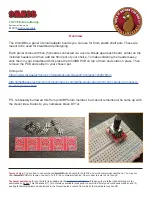
TO-BA-e-2020
9
•
Absorption and scattering: If the ultrasound propagates through any material, it
is partially absorbed. If the material through which the sound propagates has a
grain structure, the sound waves are scattered. These two effects reduce the
strength of the waves and thus the ability of the instrument to detect the
returning echo. The ultrasonic sound with higher frequency is absorbed and
scattered more than the ultrasonic sound with lower frequency. Although it
seems advisable to use a lower frequency transducer in all cases, low
frequencies are less directional than high frequencies. Therefore, a higher
frequency transducer is the better choice for determining the exact position of
small indentations or flaws in the material to be measured.
•
Transducer geometry: The physical boundary conditions of the measurement
environment sometimes determine the suitability of a transducer for a specific
measurement task. Some transducers may simply be too large to be used in
space limited areas. In addition, the contact area available for contacting the
transducer may be limited, which requires the use of a transducer with a small
contact area. Measuring on a curved surface, such as an engine cylinder wall,
may require the use of a transducer with a suitably curved contact area.
•
Temperature of the material: When measuring on very hot surfaces, high
temperature transducers must be used. These transducers are manufactured
using special materials and techniques that allow them to withstand high
temperatures without damage. In addition, care must be taken when using a
high temperature transducer to perform "Sensor
Zeroing
" or "Calibration to
Known Thickness".
The choice of the appropriate converter is often a question of compromise between
different properties. It may be necessary to test different transducers in order to find a
suitable sensor for the respective application.
The converter is the "working tool" of the device. It transmits and receives ultrasonic
waves with which the instrument calculates the thickness of the material to be
measured. The transducer is connected to the instrument via the cable supplied and
two coaxial connectors. When using transducers, the arrangement of the double
coaxial connectors is irrelevant: each connector can be connected to any of the two
jacks on the instrument.
The transducer must be used correctly in order to obtain an accurate and reliable
measurement result. Below is a brief description of the transducer, followed by its
operating instructions.










































